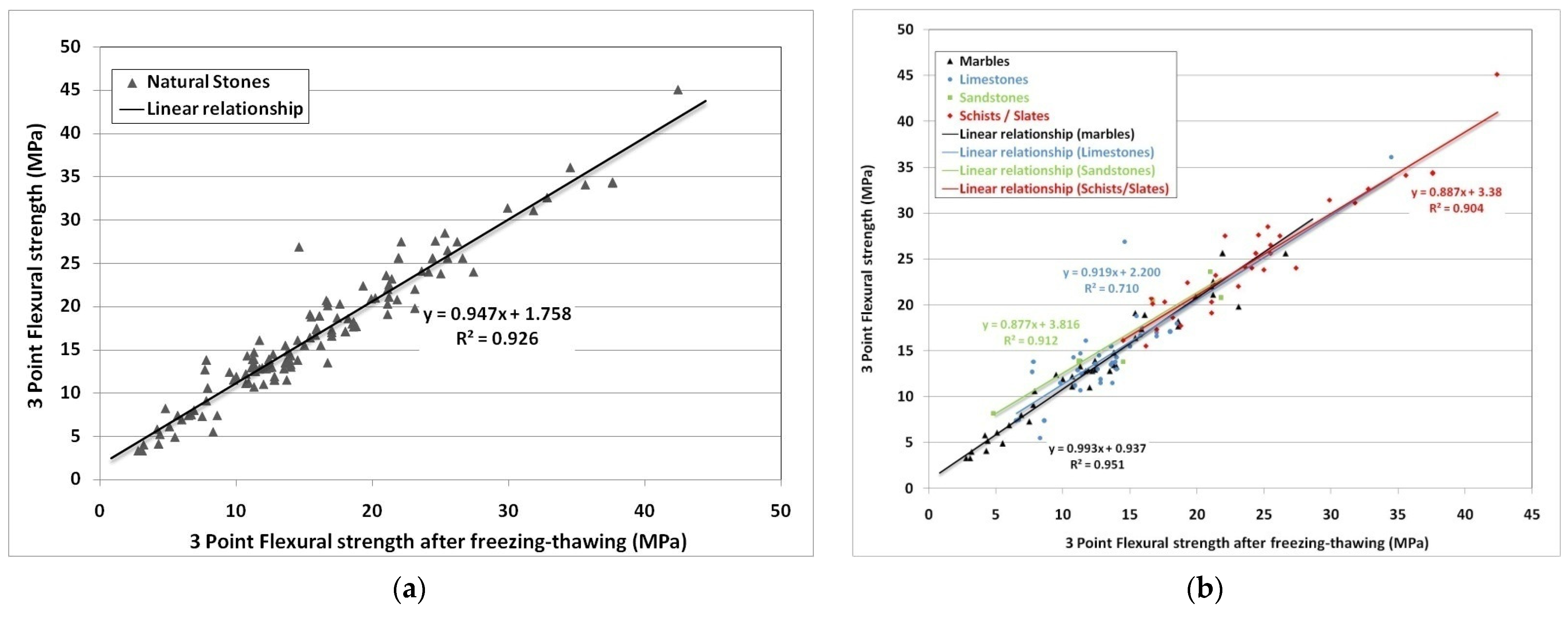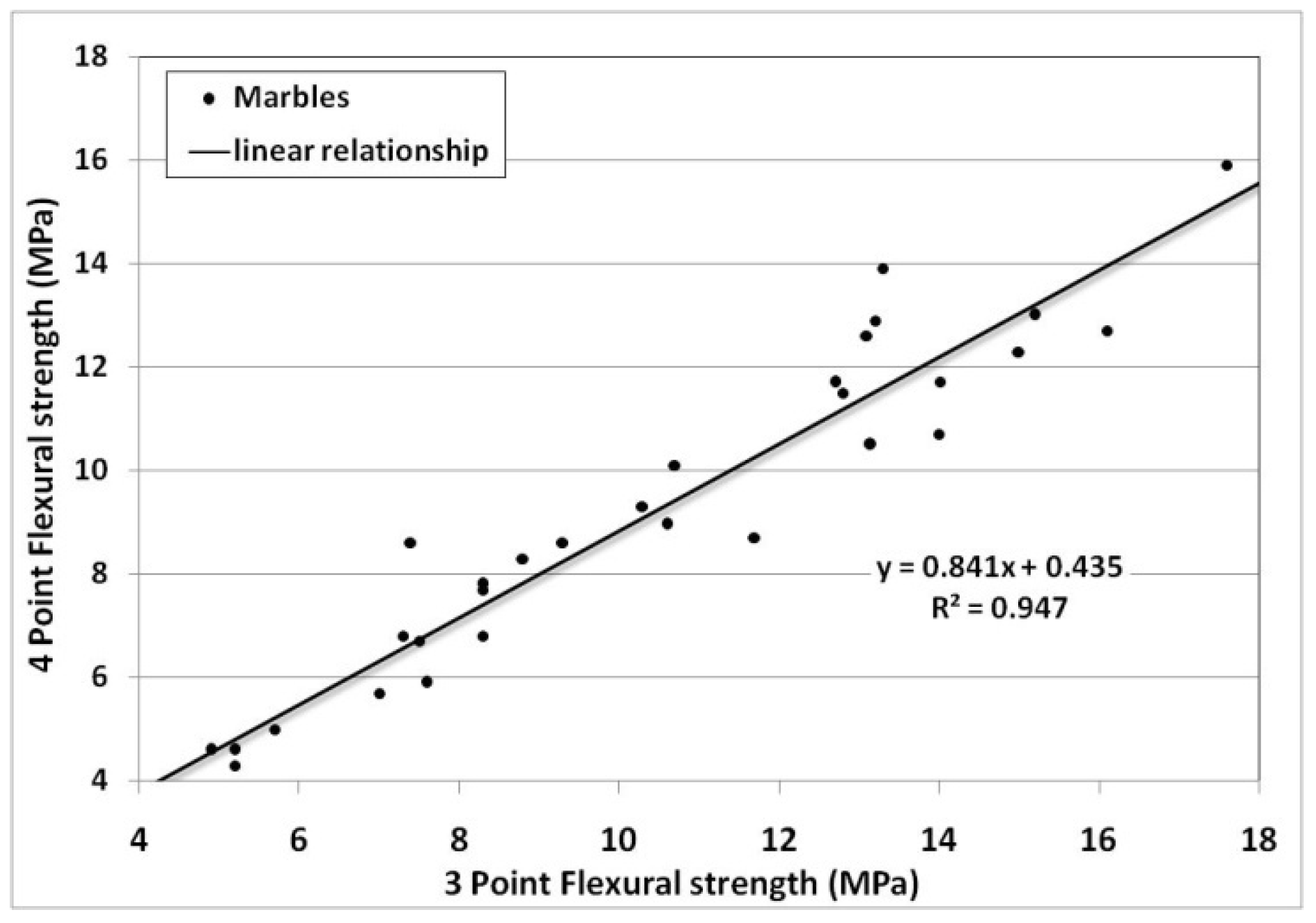Correlations between the Physical Mechanical Properties of Greek Dimension Stones †
Abstract
:1. Introduction
2. Materials and Methods
2.1. Flexural Strength
2.2. Freeze–Thaw Cycling
2.3. Thermal Shock
2.4. Water Absorption at Atmospheric Pressure and Open Porosity
3. Analysis of the Test Results
3.1. Relationship between Flexural Strength without and after Freeze–Thaw Cycling
3.2. Relationship between Flexural Strength without and after Thermal Shock
3.3. Relationship between Flexural Strength under a Concentrated Load and under a Constant Moment
3.4. Relationship between Water Absorption and Open Porosity
4. Conclusions
Institutional Review Board Statement
Informed Consent Statement
Data Availability Statement
References
- Bourgès, V.A. Holistic Correlation of Physical and Mechanical Properties of Selected Natural Stones for Assessing Durability and Weathering in the Natural Environment. Ph.D. Thesis, Dissertation der Fakultät für Geowissenschaften der Ludwigs-Maximilians-Universität, München, Germany, 2006. [Google Scholar]
- Çobanoğlu, I.; Çelik, S.B. Determination of strength parameters and quality assessment of Denizli travertines (SW Turkey). Eng. Geol. 2012, 129–130, 38–47. [Google Scholar] [CrossRef]
- Jiang, H. The Relationship between Mechanical Properties and Gradual Deterioration of Microstructures of Rock Mass Subject to Freeze-thaw Cycles. Earth Sci. Res. J. 2018, 22, 53–57. [Google Scholar] [CrossRef]
- Patronis, M.; Laskaridis, K.; Niaou, M. Relationship between Breaking Moments at the Dowel Hole and at Flexure under Concentrated Load of Ornamental Stones. Key Eng. Mater. 2013, 548, 287–294. [Google Scholar] [CrossRef]
- Senada Fonseca, B.; Castela, A.S.; Duarte, R.G.; Neves, R.; Montemor, M.F. Non-destructive and on site method to assess the air permeability in dimension stones and its relationship with other transport—Related properties. Mater. Struct. 2015, 48, 3795–3809. [Google Scholar] [CrossRef]
- Ozcelik, Y.; Ozguven, A. Water absorption and drying features of different natural building stones. Constr. Build. Mater. 2014, 63, 257–270. [Google Scholar] [CrossRef]
- Figarska -Warchoł, B.; Stańczak, G. The effect of petrographic characteristics on the physical and mechanical properties of currently exploited Pińczów Limestones—A type of Leitha Limestone (Carpathian Foredeep, southern Poland). Gospodarka Surowcami Mineralnymi 2019, 35, 59–98. [Google Scholar] [CrossRef]
- Freire-Lista, D.M.; Gomez-Villalba, L.S.; Fort, R. Microcracking of granite feldspar during thermal artificial processes. Period. Mineral. 2015, 84, 519–537. [Google Scholar] [CrossRef]
- Sengun, N. Influence of thermal damage on the physical and mechanical properties of carbonate rocks. Arab. J. Geosci. 2014, 7, 5543–5551. [Google Scholar] [CrossRef]
- Khanlari, G.; Sahamieh, R.Z.; Abdilor, Y. The effect of freeze-thaw cycles on physical and mechanical properties of Upper Red Formations and stones, central part of Iran. Arab. J. Geosci. 2015, 8, 5991–6001. [Google Scholar] [CrossRef]
- Ozbek, A. Investigation of the effects of wetting—Drying and freezing—Thawing cycles on some physical and mechanical properties of selected ignimbrites. Bull. Eng. Geol. Environ. 2013, 73, 595–609. [Google Scholar] [CrossRef]
- Park, K.; Kim, K.; Lee, K.; Kim, D. Analysis of Effects of Rock Physical Properties Changes from Freeze-Thaw Weathering in Ny-Ålesund Region: Part1—Experimental Study. Appl. Sci. 2020, 10, 1707. [Google Scholar] [CrossRef] [Green Version]
- Török, Á.; Szemerey-Kiss, B. Freeze-thaw durability of repair mortars and porous limestone: Compatibility issues. Prog. Earth Planet. Sci. 2019, 6, 42. [Google Scholar] [CrossRef] [Green Version]
- Walbert, C.; Eslami, J.; Beaucour, A.L.; Bourges, A.; Noumowe, A. Evolution of the mechanical behaviour of limestone subjected to freeze–thaw cycles. Environ. Earth Sci. 2015, 74, 6339–6351. [Google Scholar] [CrossRef]
- Yates, T.; Mauko, A. Freeze Thaw Susceptibility of Natural Stone—Characterization of the Mechanical Strength and Microstructure During Frost Cycling. In Proceedings of the DBMC International Conference on Durability of Building Materials and Components, Istanbul, Turkey, 11–14 May 2008. [Google Scholar]
- EN12372:2006. Natural Stone Test Methods—Determination of Flexural Strength under Concentrated Load; CEN/TC 246; EN Standards: Pilsen, Czech Republic, 2006. [Google Scholar]
- EN13161:2008. Natural Stone Test Methods—Determination of Flexural Strength under Constant Moment; CEN/TC 246; EN Standards: Pilsen, Czech Republic, 2008. [Google Scholar]
- EN12371:2010. Natural Stone Test Methods—Determination of Frost Resistance; CEN/TC 246; EN Standards: Pilsen, Czech Republic, 2010. [Google Scholar]
- EN14066:2013. Natural Stone Test Methods—Determination of Resistance to Ageing by Thermal Shock; CEN/TC 246; EN Standards: Pilsen, Czech Republic, 2013. [Google Scholar]
- EN13755:2008. Natural Stone Test Methods—Determination of Water Absorption at Atmospheric Pressure; CEN/TC 246; EN Standards: Pilsen, Czech Republic, 2008. [Google Scholar]
- EN1936:2006. Natural Stone Test Methods—Determination of Real Density and Apparent Density, and of Total and Open Porosity; CEN/TC 246; EN Standards: Pilsen, Czech Republic, 2006. [Google Scholar]






Publisher’s Note: MDPI stays neutral with regard to jurisdictional claims in published maps and institutional affiliations. |
© 2021 by the authors. Licensee MDPI, Basel, Switzerland. This article is an open access article distributed under the terms and conditions of the Creative Commons Attribution (CC BY) license (https://creativecommons.org/licenses/by/4.0/).
Share and Cite
Laskaridis, K.; Arapakou, A.; Patronis, M.; Kouseris, I. Correlations between the Physical Mechanical Properties of Greek Dimension Stones. Mater. Proc. 2021, 5, 28. https://doi.org/10.3390/materproc2021005028
Laskaridis K, Arapakou A, Patronis M, Kouseris I. Correlations between the Physical Mechanical Properties of Greek Dimension Stones. Materials Proceedings. 2021; 5(1):28. https://doi.org/10.3390/materproc2021005028
Chicago/Turabian StyleLaskaridis, Konstantinos, Angeliki Arapakou, Michael Patronis, and Ioannis Kouseris. 2021. "Correlations between the Physical Mechanical Properties of Greek Dimension Stones" Materials Proceedings 5, no. 1: 28. https://doi.org/10.3390/materproc2021005028
APA StyleLaskaridis, K., Arapakou, A., Patronis, M., & Kouseris, I. (2021). Correlations between the Physical Mechanical Properties of Greek Dimension Stones. Materials Proceedings, 5(1), 28. https://doi.org/10.3390/materproc2021005028





